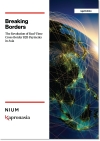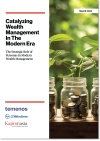"In conversation with..." is a new series from Kapronasia featuring conversations with some of Asia's most interesting fintech players and companies. To keep up with the series, please subscribe to our newsletter. If you have an interesting story and want to be part of the conversation, This email address is being protected from spambots. You need JavaScript enabled to view it..
The concept of super apps is nothing new in Asia. China's Alipay and WeChat have led the way and created a new model of e-commerce that has completely changed the way that over a billion people pay and handle their finances in China.
The competition to become the super app of Southeast Asia is intense, but one thing that all of the contenders have in common is the focus on payments. We spoke with Pratyush Prasanna, the Head of Merchant Payments at GoTo Financial, about where the market is going.
Thanks for taking the time, Pratyush. To start, we've seen both regulatory and competitive pressures compress margins on payments, online and off. Would you agree with that assessment and what is essential for payment providers to focus on, especially in the merchant space, addressing those challenges and competing effectively?
That is actually a very existential question because merchant payments have traditionally been sustained by payment margins or the merchant discount rate (MDR) volumes as a monetization mechanism, but that is changing. In certain markets for example, the MDR can now be zero. As such, for a merchant payments business to remain sustainable, MDR won't be the primary mode of monetization.
An ideal situation for a merchant payment company is to leverage its base in payments processing and build products on top. These products will help to enable better acceptance rates and fraud detection and management while providing merchants with value-added services such as better dashboards, analytics around where transactions are taking place, where we should be running promotions, and more.
Across the board, we’re increasingly seeing greater demand from merchants for products that will give them comprehensive insights on how to run their businesses better. Currently, businesses have the ability to track what customers browse, buy and wishlist, every time these customers come into their offline or online store. Fintech and payments providers, however, can provide rich insight into the consumer's entire buying and browsing experience. This allows businesses to adjust to consumer needs with customized landing pages, and also create a safer and more secure environment with enhanced fraud detection features - while adhering to personal data protection regulations.
This also helps to build significant merchant loyalty. Once you're so used to working with a dashboard that meets your business needs, you will not want to move away from it. This means that unlike consumer payments, merchant payments are very much driven by inertia - in a good way - and the motivation to move is often small, especially for a low cost difference.
What about additional financial products and services like what we've seen from Alipay and WeChat Pay?
For many payments and financial services firms, the base of the financial product pyramid is always payment processing. However, the key about that pyramid is that customer numbers decrease as we go up the pyramid, but margins increase as you move into additional products like merchant lending, consumer lending, financing and more. All of these products are value adds, which have to be built on top of payments.
To give you a better idea, we are part of the larger GoTo Financial, which provides payments, financial services and business solutions for people from all walks of life. We have lots of value adds that are built on payments, like loans. We also have POS solutions and analytics on top of these.
I think that's what the future is, where companies like GoTo Financial will explore these solutions to deliver even greater value to merchants.
If you could have three takeaways from COVID that you've noticed with the merchants you work with, or just in general from the payments industry, what would those be?
The first one is the rising trend of O2O among merchants. We have onboarded many merchants in the past two years, growing our merchant base exponentially, especially with the pandemic making it more essential than ever for businesses to have an online presence. Many of these merchants who joined our platform in recent years are smaller businesses who had a website or were doing business via WhatsApp or Instagram, but had not optimized certain parts of their business, such as payments, for online channels. By adopting solutions such as Midtrans payments gateway, they have simplified the payments process and successfully moved their entire business and operations online, which is great.
Another takeaway is the accelerated uptake in digital payments, especially for products that enable quick and simple onboarding. Our products give merchants multiple ways of accepting payments, but the ones which are easy to manage, like the e-wallets, have grown very rapidly. Smaller merchants care about getting onboarded faster and accepting payments faster. For example, one product that has seen very strong uptake among merchants due to its ease of use, is a Midtrans feature called the Payment Link.
What that does is that, if you buy something from me, I'll just send you a payment link. When you click on that link you'll see multiple payment options and pay with one of them. Previously, merchants would have to set up a website or an app and ask consumers to go to the app and pay. Now, they can copy, paste and send the link to consumers via WhatsApp, an SMS or even Instagram and pay from there. We have designed this product such that it is very light and simple for both merchants and consumers across multiple use cases. Let’s take a supermarket as an example. The cashiers can send the payment link to the customer standing at the checkout because they don't want to handle cash due to the pandemic, and the customer can choose their preferred payment method and pay instantly. Once payment has been made, the cashier gets a notification showing that the transaction was successful. It's very fast and secure, and they don't have to touch their customers’ cash or card.
I realize we're hitting on time here. Looking back, if you could go back to February 2020, what is the one thing that you wish that Gojek had in place before the pandemic started? Is there one thing you feel that if you had this in place, it would have made lives that much easier for merchants?
Even before the pandemic hit, our focus has always been on delivering comprehensive solutions to merchants and adding value to their businesses, whether they are online and offline. COVID-19 hasn’t changed this focus, but rather it has served to reinforce the importance of this omnichannel strategy, as more offline merchants begin to also develop an online presence. In line with that, we are continuing to step up efforts to provide all types of merchants with solutions that will meet their business needs, simplify their operations and enable them to grow in all circumstances.
Thank you Pratyush, this has been great.
No problem! Looking forward to catching up at PayTech Connect.
Join Pratyush’s All Star Panel: ‘As big tech (Apple, Google, Amazon etc.) move more aggressively into the payments ecosystem how will the incumbents fight back?’. Register now to attend the much-anticipated FinTech Connect Asia (Virtual Main Conference Days: 6-7th October, SGT).





